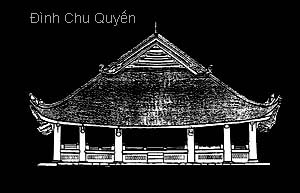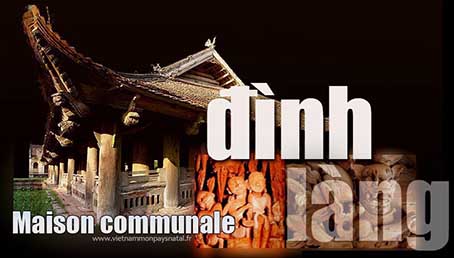Đình Làng: Part 2
We are accustomed to say: Cầu Nam, Chùa Bắc, Ðình Ðoài with the aim of evoking the celebrity of three specific regions concerning the Vietnamese traditional architecture. Ðình Ðoài thus insinuates the region Ðoài (Hà Ðông, Sơn Tây) where there is a large number of famous communal houses. (Tây Ðằng, Mông Phụ , Chu Quyến etc. .. ). It is in this region near the mountain and forests that the precious and resistant hardwood is found essentially for the construction of đình.
The word « đình » has its origin in the Chinese ideogram ting. Despite this, the « đình » in the Vietnamese architecture does not correspond to the Chinese description of the ting. The latter is employed over time to designate a isolated house for cultural joys (thưởng ngoạn văn hóa) or a rest home (đình trạm) for a traveller or a mandarin in mission or a temple for the cult of the rampart genius at the time of the Han (Chinese).
In this meaning, there is the same type of ting in Viet Nam with the đình Trấn Ba within the temple Ngọc Sơn (Hànội) or Thủy Ðình ( Ðình on water) in front of the pagoda Thầy (Chùa Thầy) (Hà Tây). Based on the origin of the word Ðình, some specialists do not hesitate to think that the cult of the Chinese « ting » has inspired the Vietnamese « đình ». For Vietnamese writer and journalist Hữu Ngọc, the wall genius have been replaced by the village tutelary genius to adapt oneself to Vietnamese taste. But there are several reasons not allowing to reinforce this hypothesis.
Firstly, the Vietnamese đình which is due to its strength in an ingenious system of columns, tenons and mortices, is built on stilts (without poured foundation). This technique allows to facilitate sometimes its movement or its re-orientation in case its initial installation does not provide prosperity and happiness to the village after several decades of exploitation.This type of construction reminds us that, for some researchers, in particular French researcher Georges Coedes, the Vietnamese « đình » was undoubtedly influenced by Indonesian architectural style.

It does not call into question what one have already discovered on Vietnamese bronze drums with the house on stilts and a curved roof. (Ngọc Lữ ). We know very well that the Dongsonian (the ancestors of the Vietnamese ) were established along the coast of North Vietnam (1 millennium before J. C. ). They were considered as « Indonesian » (or Austroasians (Nam Á in Vietnamese), the Bai Yue.
According to Vietnamese researcher Trịnh Cao Tường, specialised in the study of communal houses (đình), the architecture of Vietnamese communal house on stilts testifies to the echo of the Dongsonian mind continuing to perpetuate itself yet in the daily life of the Vietnamese people. In addition, this building type is similar to sacred common building roong (nhà rồng) that one is accustomed to find among the Austroasiatic populations, in particular highland ethnic peoples (Central Highlands of Vietnam). Analogous to the Vietnamese communal house, the building rôong cumulates a large number of social functions: board room of village committee, accommodation center for casual visitors, rallying point of all villagers etc. ..Some Vietnamese « đinh » are fitted with wooden floors serving as headquarters for meeting or sofa bed for notables and villagers. This is not the case of Chinese « ting ».
Đình Bảng (Bắc Ninh)
In the XVIII century, there are almost 11800 villages in Vietnam. This means that there are communal houses as much as villages. As the Vietnamese have the habit of saying: the water that we drink recalls the source (Uống nước nhớ nguồn), there is always within themselves a recognition, a gratitude for those who have done a great service for them and their country.
That is why nothing is surprising to see a large number of historical figures (national and local heroes) or legendary characters (Mountain genius Tan Viên for example) and benefactors considered to be part of geniuses of communal houses. Those who have done stirring deeds are not forgotten either. In addition, among these ministering geniuses, there are also the children, beggars and thieves. These ones die a violent death with a sacred hour, which gives them the supernatural powers to protect villagers against evils and misfortunes. Thanks to these communal gods, the village found not only tranquillity and prosperity but also rule, justice and morality. They are in some way the personification of this supreme authority which derives its full strength in the village itself.
Depending on their role more or less filled, they can receive royal patent (sắc phong) who grant them the grades of « genius of higher rank (or Thượng đẳng thần) » or « genius of the average rank (or Trung đẳng thần) » or the « genius of lower rank (Hạ đằng thần) « . This institution allows the king to demote those of them failing to fulfill their mission by sowing disorder in the village or letting the villagers perish. Being kept with care and jealousy in the Hậu Cung (or interior palace) these royal patents are the indescribable pride of the whole village. If the latter has not his tutelary genius, it is forced to borrow the tutelary genius of another village or to replace it by the soil genius (thổ thần). In the case where the villages are united by a common cult for the same tutelary genius, they must come to an agreement so that the feast day is fixed at a date agreed in each village and everyone can participate by sending a delegation during the procession. Unlike the temples built and maintained at public expense, the communal houses are charged to villagers because it is in fact a local worship. The wealth found in the decoration of communal houses and their dimensions depend both on the financial prosperity and the generosity of the villagers. One found in every village, some parcels of land called rice-fields of the rites (or tế điền) or rice paddies of geniuses (ruộng thần từ) whose exploitation is used to maintain the communal house and the area of which may reach several tens of mẩu (or 0.36 ha) in some villages before 1945. It is the local hierarchical authorities who are responsible for the administration of communal house and village as « a small court ». The rules, customs and traditions are applied with severity and they are more respected than the king’s authority. Women are not allowed in the đình. That is why we have a habit of saying in Vietnamese « Phép vua thua lệ làng » (the king’s authority yields to the village custom). READING MORE

